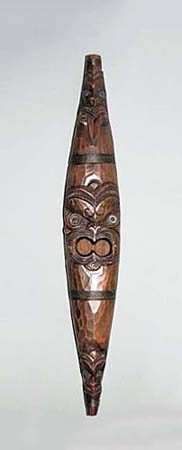
Owner: HWMC
Catalog#: OC-AEBH-01
Aerophones - Edge-Blown / Lip Vibrated
New Zealand 'Pūtōrino' Maori Bugle Flute
New Zealand
Maori – Denis Connor (carver)
Wood, flax binding and paua shell
1908 CE
Length: 19.5 in
Aerophone – Wind Instrument Proper – Edge-Blown & Lip Vibrated
Signed and Dated: Denis Connor / 1908
This 100+ year old pūtōrino, is hand carved and signed by Denis Connor – a Maori carver. During the turn of the 20th century, Maori people were made to change their names to English or Irish names, and he selected Denis Connor. I received this old pūtōrino from his grandson, Tane Connor of New Zealand, who accidentally cleaned and oiled with linseed to prevent cracking.
The pūtōrino has been called a bugle flute because it has two voices, the male and female voices. The male voice called kokiri, is produced by buzzing the lips into the top opening (waha) or mouthpiece end, much the same as playing a trumpet. The sound is modified by the placement of the fingers over the opening in the center (mangai). This trumpeting sound is used to summons or announce special happenings. The female voice of Raukatauri (cocoon of the case moth) is produced by blowing across the open end at the top, splitting a column of air, much the same as playing a flute. It produces a crying sound and is used for such occasions as funerals and other events needing a sound that evoked high emotions. A third voice, played through the central opening, is thought to be that of Raukatauri’s mysterious daughter Wheke, who, though she is never seen, is responsible for the inarticulate sounds heard in the forest.
This pūtōrino is made from two hollowed pieces of mataii wood that are lashed together. The eyes of each of the three faces are made of paua shell, which fits around extended wooden pupils. The shape of the pūtōrino is inspired by the casemoth cocoon and is believed to house “Hine Raukatauri,” goddess of flute music, who according to legend, lives in the flute. The pūtōrino is an instrument unique to the Maori and is regarded in very high esteem. This pūtōrino has the original flax binding and paua shell eyes.
Resource: “Putorino”, Mervyn McLean/Teurikore Biddle, “Groves Dictionary of Musical Instruments,” 2nd ed., Laurence Libin, Editor in Chief, Oxford University Press, Vol. 4, pg 181.
